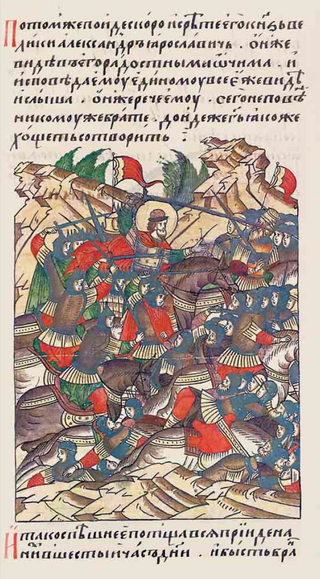
Year 1238 (MCCXXXVIII) was a common year starting on Friday of the Julian calendar.

Year 1248 (MCCXLVIII) was a leap year starting on Wednesday of the Julian calendar.

Year 1227 (MCCXXVII) was a common year starting on Friday of the Julian calendar.
The 1230s was a decade of the Julian Calendar which began on January 1, 1230, and ended on December 31, 1239.
The 1240s was a decade of the Julian Calendar which began on January 1, 1240, and ended on December 31, 1249.

Year 1239 (MCCXXXIX) was a common year starting on Saturday of the Julian calendar.

Year 1240 (MCCXL) was a leap year starting on Sunday of the Julian calendar.

Year 1242 (MCCXLII) was a common year starting on Wednesday of the Julian calendar.

The Mongol Empire invaded and conquered much of Kievan Rus' in the mid-13th century, sacking numerous cities such as Ryazan, Yaroslavl, Pereyaslavl and Vladimir, including the largest: Kiev and Chernigov. The siege of Kiev in 1240 by the Mongols is generally held to mark the end of the state of Kievan Rus', which had already been undergoing fragmentation. Many other principalities and urban centres in the northwest and southwest escaped complete destruction or suffered little to no damage from the Mongol invasion, including Galicia–Volhynia, Pskov, Smolensk, Polotsk, Vitebsk, and probably Rostov and Uglich.

Batu Khan was a Mongol ruler and founder of the Golden Horde, a constituent of the Mongol Empire established after Genghis Khan's demise. Batu was a son of Jochi, thus a grandson of Genghis Khan. His ulus ruled over the Kievan Rus', Volga Bulgaria, Cumania, and the Caucasus for around 250 years.

Yuri II, also known as George II of Vladimir or as Georgy II Vsevolodovich, was the fourth Grand Prince of Vladimir who presided over the Principality of Vladimir-Suzdal at the time of the Mongol invasion of Kievan Rus'.

The siege of Ryazan happened in Ryazan on December 1237 during the Mongol invasion of Kievan Rus'. Ryazan was capital of the Principality of Ryazan, and was the first Kievan Rus' city to be besieged by the Mongol invaders under Batu Khan.

The Principality of Ryazan, later known as the Grand Principality of Ryazan, was a principality from 1129 to 1521. Its capital was the city of Ryazan, now known as Old Ryazan, which was destroyed in 1237 during the Mongol invasions. The capital was moved to Pereyaslavl-Ryazansky, later renamed Ryazan.
The Tale of the Destruction of Ryazan (by Batu) (Russian: Повесть о разорении Рязани Батыем, romanized: Povest' o razorenii Riazami Batyem) is a Russian literary work about the capture of the city of Ryazan by the Mongols in 1237. It is compiled from earlier manuscripts.
'Al-Malik al-Kamil Muhammad ibn al-Muzaffar Ghazi ibn al-Adil Abu Bakr was the son of al-Muzaffar Ghazi and the last Ayyubid emir (prince) of Mayyafariqin (1247–1260). He is also known as Al Kamil Muhammad II to distinguish from his uncle Al Kamil Muhammad I.

The Battle of Voronezh River happened during the Mongol invasion of Kievan Rus'. The Principality of Ryazan was the first to be attacked.

Yury or Yuri Ingvarevich also known as Yuri Igorevich, was Grand Prince of Ryazan from 1235 until his death in 1237 during the siege of Ryazan as part of the Mongol invasions.
The siege of Kolomna during December 1237–January 1238 was part of the Mongol invasion of Kievan Rus'. Following the Battle of Voronezh River in December 1237, Yuri II of Vladimir sent both of his sons with "all his men" and Voivode Yeremey to defend the fortress of Kolomna, which was on the border to the Wild Fields.

The siege of Vladimir in February 1238 was part of the Mongol invasion of Kievan Rus'.
The siege of Moscow in January 1238 was part of the Mongol invasion of Kievan Rus'.












